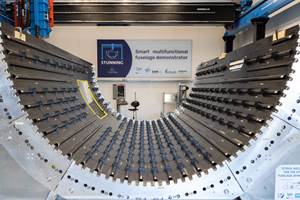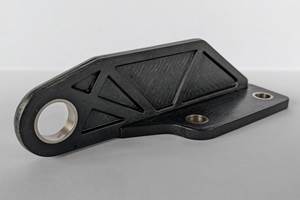Fighting Ships Augment Combat Readiness With Advanced Composites
Navies adopt composite materials for stealth and speed.
Stealth, speed and light weight have become as important as sophisticated weaponry in the new age of warfare. This is no less true for the world's navies as for land-based forces. Traditional naval aircraft carriers, battleships and destroyers are awe-inspiring from the standpoint of sheer size and firepower. Yet, these deepwater metallic behemoths are vulnerable to mines, torpedoes and sea-skimming missiles. Naval forces are increasingly turning to faster and more maneuverable craft for special intercept operations and strategic attacks in near-shore waters less than 20 ft deep.
Composite materials have long been recognized by naval designers for their non-magnetic properties, which led to development of mine sweeper vessels that can safely find and destroy modern metal-sensing mines. All-composite minehunters have plied the seas since early 1972, when the British warship H.M.S. Wilton was launched. In addition, natural damping and insulating properties give a composite vessel a less distinct acoustic signature, making it more difficult to detect with sonar. In line with stealth aircraft design, naval architects recognize that hulls and superstructures made with large, flat panels can reflect and redirect radar signals. And, a lightweight composite hull teamed with high-horsepower engines and waterjet propulsion systems mean high speeds, low displacement and shallow draft.
European navies have embraced composite ship technology wholeheartedly, mainly because of the presence of sea mines placed during past conflicts. Dozens of large composite craft have been fabricated in Norway, Sweden and the U.K. for a diverse customer group. Because U.S. waters have never been mined, the U.S. Navy has been slower to accept all-composite construction, although radomes, enclosed masts and other components have been employed. But, major mine damage to vessels during the Desert Storm conflict in the Persian Gulf has accelerated U.S. development of naval composites. Twelve composite warships in the Osprey coastal minehunter (MHC) class were built with fiberglass/polyester by U.S. shipyards during the 1990s. Today, the U.S. Navy is sponsoring the Focused Mission Vessel Study, hoping that it will result in a new generation of high-speed, stealthy and, possibly, all-composite ships. Eric Greene, a naval composites expert who recently produced the reference work Marine Composites, sets that hope in historical context. "Going from wood to steel as the hull material of choice during the 19th century was a profound change for the Navy," he says. "For the 21st century, composite materials promise to be the next quantum leap for warship construction."
All-carbon ship a first
Kockums AB (Malmö, Sweden) has been constructing ships for more than 320 years. While most of its products have used wood and metal, the company's Karlskrona Shipyard in southeastern Sweden readily adopted composite construction techniques in the late 1960s and early 1970s when the company recognized the design benefits for minehunters and fast coastal patrol boats, says Sven-Erik Hellbratt, Karlskrona's design manager and director of composite structures. Kockums parent Howaldtswerke-Deutsche Werft AG (Keil, Germany) also is experienced in composites construction, having designed and built a number of submarines that incorporate composite sandwich structure, including the 212 Class for the German Navy.
Kockums launched the all-composite minehunter MS Viksteen in 1974, and today is constructing the fourth of six carbon fiber/vinyl ester Visby corvettes — the first military vessels to be built entirely of carbon fiber — for the Royal Swedish Navy.
"Up to a length of about 130m, a properly designed carbon fiber vessel can be justified from both a technical and economic standpoint," says Hellbratt. "A weight savings of 50 percent compared to conventional steel is achievable, without a significant increase in total construction cost."
Sweden's stealthy composite corvettes are equipped for mine clearance, anti-submarine warfare, surface combat, marine surveillance and larger vessel protection duties. Fast and maneuverable, the 72m/236-ft-long warships are powered by two diesel-engine-driven waterjet propulsors capable of delivering speeds as high as 35 knots/40 mph for short durations.
Hellbratt explains that carbon fiber was the best choice to meet all of the project objectives. The hull had to be extremely lightweight, yet strong and rigid enough to withstand wave slam loads generated by high speeds in North Atlantic seas, as well as shock loads caused by exploding mines. Numerical models were developed to optimize the craft's structure. Optimization runs were performed using ANSYS Inc.ANSYS software from ANSYS Inc. (Canonsburg, Pa., U.S.A.), showing that a cored carbon fiber sandwich structure was as cost-effective as a glass laminate hull, because only one-third the material was needed to achieve the same strength. Multiple model iterations using different methods for calculating hull loads led to some late design changes, says Hellbratt.
"When we modeled higher loads, we managed to still achieve high performance without a big weight increase," he explains. "The price we paid was a more complex design with a lot more unidirectional fibers in certain areas rather than a more balanced layup."
An important part of the design was the use of polyvinyl chloride (PVC) structural foam core manufactured by DIAB Americas LP (Laholm, Sweden). DIAB's Divinycell foam was specified throughout the entire vessel, while ductile Divinycell HD grade was used for the more highly stressed areas below the waterline, says Hellbratt. The tougher, higher-density HD foam has the capability to absorb large quantities of energy, with a shear strain at failure of approximately 45 percent. This ductility enables the vessel to absorb shock loads without fracturing or delaminating.
Given the vessel's large size, the shipyard had to adopt cost-effective and fast, room-temperature fabrication methods. Clearly, hand layup of the hull and superstructure would not only have been very costly, but the resulting air emissions would have run counter to Swedish health legislation as well, explains Hellbratt. The shipyard chose instead to vacuum-bag and resin-infuse large sandwich panels, up to 60m2/635 ft2 in size, using an in-house infusion technique the shipbuilder developed 10 years ago, known as KVASI, which stands for Kockums vacuum-assisted sandwich infusion. DIAB supplies its "kerfed" or grid-scored core sheets that allow resin flow paths during infusion. (The core sheets themselves are bonded together with a high-strength, very high-elongation adhesive.) Reichhold LLC2 (Research Triangle Park, N.C., U.S.A.) vinyl ester resin is introduced on the underside of the panel, with vacuum on the upper side of the panel, and resin flows through the core channels for complete wetout of the upper and lower skins. Hellbratt says the KVASI method ensures that the resin front will not go faster in an upper layer, leaving an unimpregnated or partly-impregnated fiber layer close to the core. After cure, the sandwich panels are waterjet cut to produce several parts, then butted together, adhesively bonded and overlaminated to form the vessel hull and bulkheads. Hellbratt reports that 60 percent by weight (50 percent by volume) fiber content is achieved using infusion, with less than 1 percent voids.
Multiaxials for fast layup
After testing several carbon fiber types, Kockums selected a high-strength Toray Industries Inc. (Tokyo, Japan) T700 fiber for its elongation-at-break of 2 percent, which is higher than that of other intermediate-modulus fibers. Devold AMT AS (Langevåg, Norway) converts the T700 fibers into stitched nonwoven multiaxials — essentially multiple plies of unidirectional fibers, with each ply in a different orientation, held together by stitching — for the sandwich skins, in widths that range from 1.3m to 3.2m/50 inches to 126 inches. The fiber architecture of the multiaxials varies depending on the strength requirements of each area of the hull, and can incorporate as many as 40 plies oriented to deliver the required performance specifications while maintaining ease of use, says DeVold AMT's marketing manager Baard Rosvik. "Traditional woven fabrics with crimp can reduce the mechanical properties of the laminate," he notes. "With the nonwoven multiaxials, Kockums can achieve higher fiber volume with higher compression strength."
Vinyl ester resin, toughened with rubber additives, was chosen for the infusion process, because it achieves higher strength properties than polyester and has a lower viscosity than epoxy, for rapid wetout during infusion. An issue with carbon fiber is that traditionally it has been "sized" or treated during production with materials compatible only with epoxy resins, making it difficult to laminate with polyesters or vinyl esters. Toray worked with the shipyard to develop a modified fiber sizing for compatibility with the vinyl ester resin, says Hellbratt.
"The new fiber sizing has increased the delamination strength of the laminate up to 25 percent compared to the previous fiber sizing," he explains. "The 12K T700 carbon fiber in combination with rubber-modified vinyl ester demonstrates almost the same mechanical laminate properties, tensile strength and delamination strength as for epoxy laminates."
The flat panel parts are joined together to form precise, faceted hull and superstructure shapes. Once all sections are joined, the entire vessel is postcured at 60°C/166°F in a heated oven-like enclosure for improved strength properties. The smooth, flat surfaces reduce radar signature by reflecting radar signals in specific directions. The ship's stealth characteristics are greatly enhanced by the total absence of metallic fasteners or metal railings and ladders. The PVC foam core helps insulate the ship's acoustic and heat signals. Because of carbon's conductivity, the ship requires no additional electromagnetic (EM) shielding to hide its communications signatures.
The high-tech Visby corvettes are outfitted with embedded accelerometers and strain gauges in the most highly stressed areas of the hull. The sensors transmit real time stress and strain data to the captain, who can adjust speed as needed to avoid undue stresses. Sea trials in bad weather conditions have shown that actual measured loads are close to those predicted by the numerical models. Hellbratt says that slamming load peak pressure is close to predicted but somewhat shorter in duration, which means that structural assumptions are on the safe side. With added phenolic/glass insulation and intumescent coatings on the interior bulkheads, the ship meets all International Maritime Organization (IMO) fire safety requirements, as verified by fire testing.
Glass design solutions
Umoe Mandal AS (Mandal, Norway) and Vosper Thornycroft Shipbuilding (VT, Portchester, U.K.) have both adopted fiberglass designs, in contrast to Kockums' carbon approach.
"Bear in mind that single-role minehunters (Sandown and Hunt Class) built for customers like the U.K. MoD and the Royal Saudi Navy are not built for speed, they're built primarily for their non-magnetic properties and toughness," says VT's composites designer Ajay Kapadia.
VT, builder of the H.M.S. Wilton, has constructed more than 20 53m/172-ft-long minehunter hulls as solid E-glass/polyester (uncored) laminates with structural ribs and stringers. The resulting structure is strong and tough with very high deflection and flexibility, able to absorb the punishing shock loads from mine detonation. Kapadia won't detail specific fiber architecture or number of fabric plies used in the hand layed up hull, but has revealed that the final laminate thickness is between 25 mm and 50 mm/1 inch to 2 inches, representing at least 50 plies.
The vessel's superstructure is made by resin-infusing large, flat, solid laminate panels made with E-glass fabrics. The layup incorporates an embedded copper mesh for electromagnetic shielding. Infusion resin is Derakane vinyl ester from The Dow Chemical Co. (Midland, Mich., U.S.A.). After room temperature cure, panels are cut to the correct shape then joined together with a resin-infused scarf joint.
Earlier this year, VT announced a new composite vessel design called the Fast Response Boat (FRB). With a top speed exceeding 50 knots/57.5 mph, the FRB is a high-speed armed patrol vessel for coastal defense, with diesel/waterjet propulsion. The new 48m/156-ft long, shallow draft ship will be made with a glass fiber/vinyl ester infused hull designed for a light hull weight and very high speeds. Kapadia says that VT considered carbon fiber for the FRB hull. Resin-infused carbon/epoxy and carbon/epoxy prepreg were found to save only 3 percent and 15 percent, respectively, in terms of weight, with a large cost penalty. "Some carbon will likely be used to provide localized stiffness," says Kapadia.
Umoe Mandal builds its Mine Countermeasures Vessels (MCMV) from E-glass/rubber-toughened vinyl ester sandwich panels cored with high-density PVC foam. Some carbon fiber is used in highly-loaded areas. The vessel design is based on the company's Surface Effect Ship (SES) technology, essentially a catamaran/hovercraft combination. Huge composite fans hold the twin hulls up out of the water on a cushion of air, thus exposing very little hull area to the shock loads of mine detonation. This reduces design requirements for greater weight and cost savings. The company also produces the Skjold Class Fast Patrol Boat for the Royal Norwegian Navy, similar to the MCMV but smaller and faster.
More composite warships in the works?
While the U.S. Navy did develop and commission a fleet of fiberglass composite minehunters during the 1990s, its focus has historically been on "blue water" or large-draft, ocean-going vessels. However, the realities of recent U.S. military operations, particularly in the Arabian Gulf area, have led the Navy to consider new vessels for littoral (i.e., shallow coastal) waters, versatile ships that can be reconfigured for many types of missions, and that can achieve speeds up to 50 knots. As many as 60 littoral combat ships (LCS) could be commissioned in the next 25 years. One composites industry insider says that the Navy wants an LCS ship in the water by 2007, an extremely optimistic target in his opinion.
The Navy recently selected three contractors to develop preliminary designs for a LCS — possibly an all-composite vessel that may incorporate significant quantities of carbon fiber. The three selected teams — Lockheed Martin (with partners Gibbs & Cox and Bollinger Shipyards), Bath Iron Works (a General Dynamics company) and Raytheon Integrated Defense Systems (teamed with John J. McMullen Assoc. and Umoe Mandal) — are tasked with developing an LCS design by early 2004. Steel and aluminum as well as composites are under consideration. Bath Iron Works is focusing on a multihull trimaran design to reach required speeds of an LCS. Lockheed Martin's proposed design is the Sea Blade, an affordable low-draft monohull. Raytheon is developing an SES-like catamaran.
John B. Foley, vice president of Northrop Grumman Ship Systems' Gulfport shipyard and a former Naval officer, says that carbon construction is certainly one of the Navy's "preferred options" because of low life-cycle costs. With no rust or corrosion, ship maintenance costs will be significantly smaller than those for steel or aluminum-hulled ships. The disadvantage is that the material acquisition costs are higher on the front end. Noting that construction labor costs are about the same for a composite and a metal-hulled vessel, Foley says, "The return on investment would seem to point us to a composite solution for ships up to 300 ft to 400 ft in length — any longer than that just wouldn't be practical."
In short, composites offer big advantages for seagoing military vessels — advantages that naval designers are recognizing and exploiting. New global warfare realities are forcing adoption of new, agile, stealthy and versatile composite vessels, from tough flexible minehunters to fast coastal patrol boats. Kockums' Hellbratt concludes, "The reduction of weight achieved by using advanced composites allows increased ship performance by extending range and speed."
Related Content
Thermoplastic composites welding: Process control, certification, crack arresters and surface prep
More widespread use of welded composite structures within a decade? Yes, but further developments are needed.
Read MoreOptimizing a thermoplastic composite helicopter door hinge
9T Labs used Additive Fusion Technology to iterate CFRTP designs, fully exploit continuous fiber printing and outperform stainless steel and black metal designs in failure load and weight.
Read MoreMulti-material steel/composite leaf spring targets lightweight, high-volume applications
Rassini International was challenged by Ford Motor Co. to take weight out of the F-150 pickup truck. Rassini responded with a multi-material steel/composite hybrid leaf spring system that can be manufactured at high volumes.
Read MoreOne-shot manufacture of 3D knitted hybrid thermoplastic composite structures
MAPICC 3D project replaces steel seat support in heavy-duty vehicle with a 3D knitted composite made from thermoplastic hybrid yarns comprising the matrix and reinforcing components.
Read MoreRead Next
Composites end markets: Energy (2024)
Composites are used widely in oil/gas, wind and other renewable energy applications. Despite market challenges, growth potential and innovation for composites continue.
Read MoreFrom the CW Archives: The tale of the thermoplastic cryotank
In 2006, guest columnist Bob Hartunian related the story of his efforts two decades prior, while at McDonnell Douglas, to develop a thermoplastic composite crytank for hydrogen storage. He learned a lot of lessons.
Read MoreCW’s 2024 Top Shops survey offers new approach to benchmarking
Respondents that complete the survey by April 30, 2024, have the chance to be recognized as an honoree.
Read More






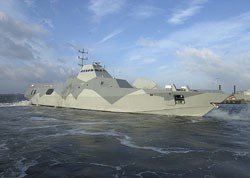
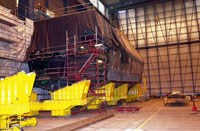
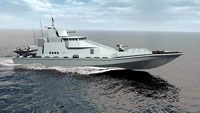









.jpg;maxWidth=300;quality=90)







